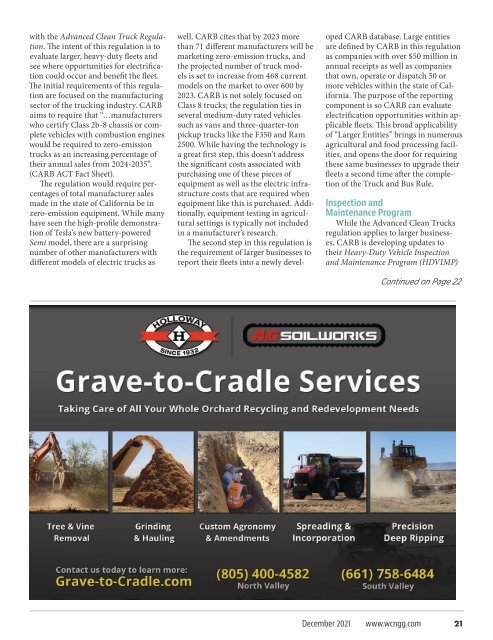WCN Dec e
Create successful ePaper yourself
Turn your PDF publications into a flip-book with our unique Google optimized e-Paper software.
with the Advanced Clean Truck Regulation.<br />
The intent of this regulation is to<br />
evaluate larger, heavy-duty fleets and<br />
see where opportunities for electrification<br />
could occur and benefit the fleet.<br />
The initial requirements of this regulation<br />
are focused on the manufacturing<br />
sector of the trucking industry. CARB<br />
aims to require that “…manufacturers<br />
who certify Class 2b-8 chassis or complete<br />
vehicles with combustion engines<br />
would be required to zero-emission<br />
trucks as an increasing percentage of<br />
their annual sales from 2024-2035”.<br />
(CARB ACT Fact Sheet).<br />
The regulation would require percentages<br />
of total manufacturer sales<br />
made in the state of California be in<br />
zero-emission equipment. While many<br />
have seen the high-profile demonstration<br />
of Tesla’s new battery-powered<br />
Semi model, there are a surprising<br />
number of other manufacturers with<br />
different models of electric trucks as<br />
well. CARB cites that by 2023 more<br />
than 71 different manufacturers will be<br />
marketing zero-emission trucks, and<br />
the projected number of truck models<br />
is set to increase from 468 current<br />
models on the market to over 600 by<br />
2023. CARB is not solely focused on<br />
Class 8 trucks; the regulation ties in<br />
several medium-duty rated vehicles<br />
such as vans and three-quarter-ton<br />
pickup trucks like the F350 and Ram<br />
2500. While having the technology is<br />
a great first step, this doesn’t address<br />
the significant costs associated with<br />
purchasing one of these pieces of<br />
equipment as well as the electric infrastructure<br />
costs that are required when<br />
equipment like this is purchased. Additionally,<br />
equipment testing in agricultural<br />
settings is typically not included<br />
in a manufacturer’s research.<br />
The second step in this regulation is<br />
the requirement of larger businesses to<br />
report their fleets into a newly developed<br />
CARB database. Large entities<br />
are defined by CARB in this regulation<br />
as companies with over $50 million in<br />
annual receipts as well as companies<br />
that own, operate or dispatch 50 or<br />
more vehicles within the state of California.<br />
The purpose of the reporting<br />
component is so CARB can evaluate<br />
electrification opportunities within applicable<br />
fleets. This broad applicability<br />
of “Larger Entities” brings in numerous<br />
agricultural and food processing facilities,<br />
and opens the door for requiring<br />
these same businesses to upgrade their<br />
fleets a second time after the completion<br />
of the Truck and Bus Rule.<br />
Inspection and<br />
Maintenance Program<br />
While the Advanced Clean Trucks<br />
regulation applies to larger businesses,<br />
CARB is developing updates to<br />
their Heavy-Duty Vehicle Inspection<br />
and Maintenance Program (HDVIMP)<br />
Continued on Page 22<br />
<strong>Dec</strong>ember 2021 www.wcngg.com 21

















